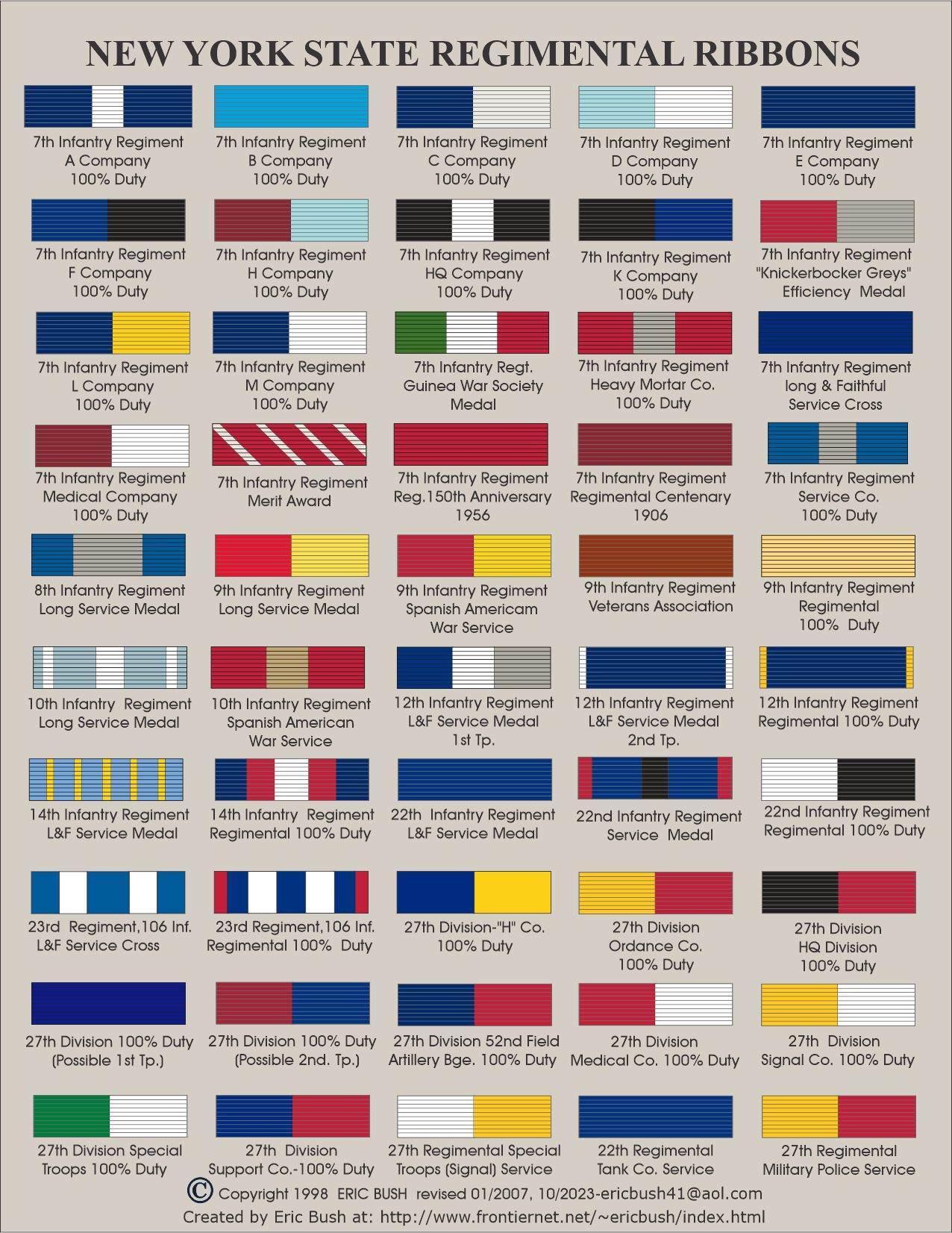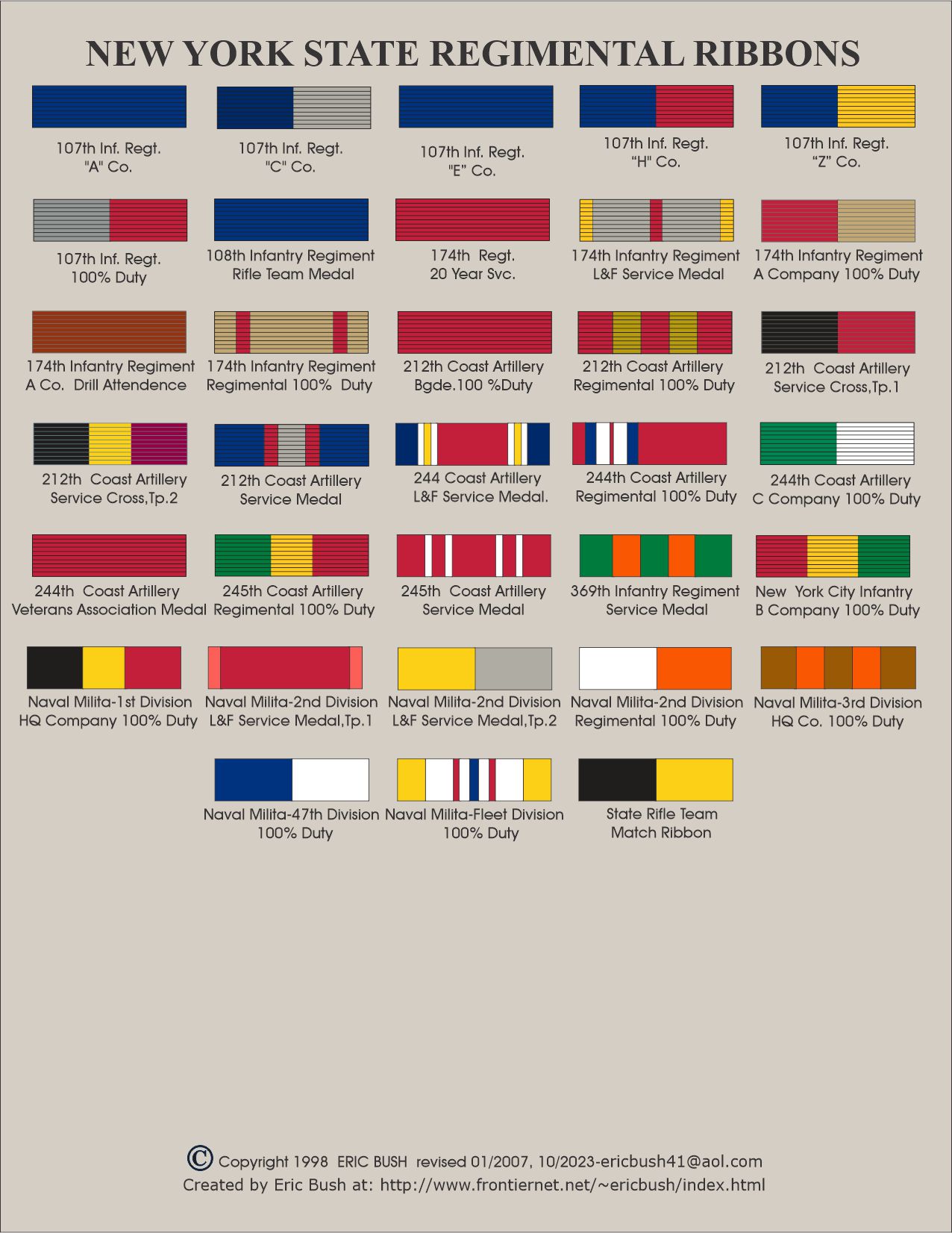
Chart 2

Chart 3

At that time I had in the region of 120 ribbons which were thought to be from New York. Alas I could only find 17 of them on the chart. A little later came the two excellent works, by Gregg Ogletree on Military Awards of the States in general and that by Paul Till on the Awards of the Empire State (NY). Again I searched but did not increase my verifications by very much. There was just no mention of the vast majority of my NY ribbons, numbering 100 or more.
I then thought about what I should do. Should I discard them or keep them? Probably, if they had been all plain or bi-coloured ribbons, I would not have bothered with them further but some had extremely attractive designs which I had not encountered anywhere else, so I persisted. It also occurred to me that most of them were blessed with a regimental description such as 174th Infantry Regiment L&FSM or Naval Militia Fleet Division 100% Duty ribbon. So I began to wonder if they were, in fact, regimental ribbons. I felt that if anyone knew anything about the matter it would be Paul Till. So, I wrote to him and was promptly rewarded with a great deal of detailed and interesting information. Included in which he encapsulated, in a few sentences, the outline story of these awards as follows:
“The heyday of these awards (NY Regimental Medals) was from 1880 to 1917. They declined after the Great War and with few exceptions, disappeared after World War II. Economics is one of the reasons for this trend. The 1880-1917 units were voluntary associations. Members of a company or regiment could reject application for membership. To a degree they were private clubs. Some, like the 7th Infantry Regiment contained the so called (wealthy) ‘better class’ of society as members. Others were largely composed of one ethnic group, like the Irish 69th Infantry Regiment. Members of some units paid annual dues. With a wealthy member unit the dues were higher and from them came the funds for a wide range of medals - in the 7th Infantry Regiment not only were there regimental medals; there were also company medals, athletic medals, etc. Regiments like the 69th Infantry, with less affluent members could only afford one or two medals. The number of medals did not necessarily reflect a unit’s attainments - the 69th Infantry was a top notch outfit.
World War I began the end of the ‘private clubs’. Men from regiments were mixed together to form the enlarged wartime units. After the war, while some of the social ‘snobbery’ remained with some regiments, the private wherewithal to fund various medals declined and after World War II virtually disappeared.
Another development also caused the decline of regimental medals. When they first appeared after the Civil War (1865) there were few federal or state portable medals (inclusive of shooting badges). Regimental medals filled this void. Starting with some shooting badges in the 1880’s, accelerating in the 1890-1910 period with NY State long service and shooting awards and federal campaign medals, and thereafter with all types of awards the void disappeared. By the 1950’s federal predominance had reached the point where even State awards were declining.
Long service and the 100% Duty medals were premier awards………..”
I was most grateful for this information as it put my ribbons into perspective at least, if not positively identifying them all individually. This is the most important aspect of the hobby, it cannot just be “adding another ribbon to the 9,275 I already have”. For anyone wishing a more detailed insight into these awards Paul Till wrote an article which was published in the Medal Collector (OMSA Journal) over a number of issues: Sept, Oct & Nov, 1979; Jan, Feb & Mar, 1980; and a supplement in Jun 1980.
This short article, and the Accompanying charts, does not set out to verify any New York regimental ribbons. That is a process which will probably never now be possible. All it attempts to do is to describe the designs and designations that I have in my albums under the heading of New York Regimental ribbons. It does not include any ribbons we now know to be State or Police awards. No doubt some of you will recognise many of these descriptions and will have many (or more) of the ribbons. That in itself does not make them correct. We may all have been working from the same (possibly wrong) sources. However, I am encouraged by the fact that on a recent visit another friend from the States brought me 40 mounted New York regimental ribbons; in no less than 38 instances the designs and descriptions were identical with ribbons I already had. Again, that does not make them correct but ……
The ribbon descriptions are, as they always will be in this sort of exercise, hopelessly inadequate as many of the colours are richer and faded and lack that pristine (awful) colour quality we find in modern ribbons. But it is hoped that if you find time to colour the charts that you will be able to give a tentative place to those bi-colours among your unknowns.
I am grateful to Paul Till for his information
and for allowing me to quote from his correspondence.
M.J. SHEPHERD
(The article was published as a supplement to
the Jigsaw, the journal of the OMRS Ribbon Branch
sometime in the early 1990’s).


